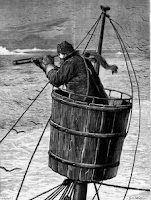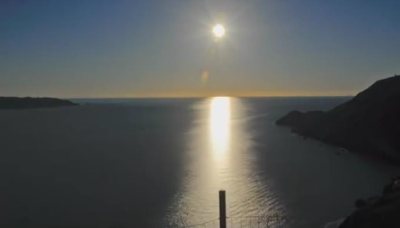81. The Dunkirk Light at a height of 194 feet should not be visible from a ship 28 miles away on a spherical Earth
“The distance from which various lighthouse lights around the world are visible at sea far exceeds what could be found on a ball-Earth 25,000 miles in circumference. For example, the Dunkerque Light in southern France at an altitude of 194 feet is visible from a boat (10 feet above sea-level) 28 miles away. Spherical trigonometry dictates that if the Earth was a globe with the given curvature of 8 inches per mile squared, this light should be hidden 190 feet below the horizon.”
Probably a bogus observation, but in any case Dubay and Samuel Rowbotham can't do trigonometry.
For evidence that the quoted observation is bogus, click here:
Why Dubay's lighthouse quotes are bogus
However, if you want to take the observation as genuine read on to see why this still does not add up to a proof.
.
Firstly Dubay again uses the incorrect calculation to determine how high the observer needs to be to see the light.
Using the correct calculation, the observer on the ship would have to be at a height of 79 feet.
On the face of it that would mean that Dubay's observer would be 69 feet too low to see the lighthouse.
However as we have learnt, it is always best to fact check Dubay because he likes to make things up.
As with so many of Dubays "proofs" this is taken from Samuel Rowbotham's "Zetetic Astronomy: Earth Not a Globe" published in 1881.
If we look at the original text from that book we find that no mention is made of the height of the observer. This means that Dubay has made up the 10 foot observer height figure off the top of his head.
The relevant paragraphs from the book are:

Now the observation can make sense on spherical Earth. In 1881 the ships that would be observing the lighthouse would be sailing ships or steam ships that still had sails as a back-up. Look-outs on those ships would be placed in a crows nest near the top of the main mast.
 So in summary, Samuel Rowbotham may have quoted an accurate account of how far out to sea the lighthouse could be seen, but he was still as ignorant of trigonometry as Dubay. He performed the incorrect calculation and used this to incorrectly conclude that the Earth could not be a sphere. Although it would have made no difference to his conclusion, he also makes the mistake of assuming that the ships lookout would be standing on the deck when the best vantage point on a sailing ship is from the top of the main mast / crows nest.
So in summary, Samuel Rowbotham may have quoted an accurate account of how far out to sea the lighthouse could be seen, but he was still as ignorant of trigonometry as Dubay. He performed the incorrect calculation and used this to incorrectly conclude that the Earth could not be a sphere. Although it would have made no difference to his conclusion, he also makes the mistake of assuming that the ships lookout would be standing on the deck when the best vantage point on a sailing ship is from the top of the main mast / crows nest.
Dubay then copies this account and for good measure reduces the elevation of the observer to 10 foot. I don't know why he would bother to do this, but my belief is that he is a compulsive liar.
An interesting aside is that Dunkirk is actually situated on coast of the northern most part of France, not the south coast as Samuel Rowbotham states. It seems that Samuel Rowbotham was as sloppy with his fact checking as Dubay.
< Prev 81-90 Next >
Probably a bogus observation, but in any case Dubay and Samuel Rowbotham can't do trigonometry.
For evidence that the quoted observation is bogus, click here:
Why Dubay's lighthouse quotes are bogus
However, if you want to take the observation as genuine read on to see why this still does not add up to a proof.
.
Firstly Dubay again uses the incorrect calculation to determine how high the observer needs to be to see the light.
Using the correct calculation, the observer on the ship would have to be at a height of 79 feet.
On the face of it that would mean that Dubay's observer would be 69 feet too low to see the lighthouse.
However as we have learnt, it is always best to fact check Dubay because he likes to make things up.
As with so many of Dubays "proofs" this is taken from Samuel Rowbotham's "Zetetic Astronomy: Earth Not a Globe" published in 1881.
If we look at the original text from that book we find that no mention is made of the height of the observer. This means that Dubay has made up the 10 foot observer height figure off the top of his head.
The relevant paragraphs from the book are:
"Many instances could be given of lights being visible at sea for distances which would be utterly impossible upon a globular surface of 25,000 miles in circumference. The following are examples:-
....
Allowing 16 feet for the altitude of the observer .....
The Dunkerque Light, on the south coast of France, is 194 feet high, and is visible 28 statute miles. The ordinary calculation shows that it ought to be 190 feet below the horizon."

Now the observation can make sense on spherical Earth. In 1881 the ships that would be observing the lighthouse would be sailing ships or steam ships that still had sails as a back-up. Look-outs on those ships would be placed in a crows nest near the top of the main mast.
"... masts were still to be found on many merchant and passenger ships well into the 1900s"
Source: https://www.uh.edu/engines/epi1338.htmThe 79 feet of elevation required to see the Dunkirk Light on a spherical Earth is absolutely consistent with the elevation we could expect for look outs stationed on the main mast.
 So in summary, Samuel Rowbotham may have quoted an accurate account of how far out to sea the lighthouse could be seen, but he was still as ignorant of trigonometry as Dubay. He performed the incorrect calculation and used this to incorrectly conclude that the Earth could not be a sphere. Although it would have made no difference to his conclusion, he also makes the mistake of assuming that the ships lookout would be standing on the deck when the best vantage point on a sailing ship is from the top of the main mast / crows nest.
So in summary, Samuel Rowbotham may have quoted an accurate account of how far out to sea the lighthouse could be seen, but he was still as ignorant of trigonometry as Dubay. He performed the incorrect calculation and used this to incorrectly conclude that the Earth could not be a sphere. Although it would have made no difference to his conclusion, he also makes the mistake of assuming that the ships lookout would be standing on the deck when the best vantage point on a sailing ship is from the top of the main mast / crows nest.Dubay then copies this account and for good measure reduces the elevation of the observer to 10 foot. I don't know why he would bother to do this, but my belief is that he is a compulsive liar.
An interesting aside is that Dunkirk is actually situated on coast of the northern most part of France, not the south coast as Samuel Rowbotham states. It seems that Samuel Rowbotham was as sloppy with his fact checking as Dubay.
< Prev 81-90 Next >





Comments
Post a Comment